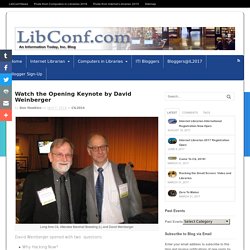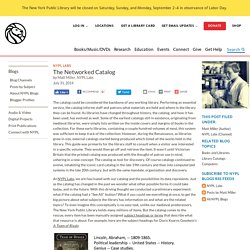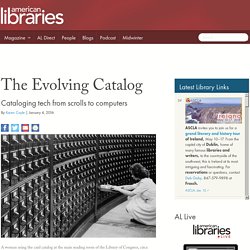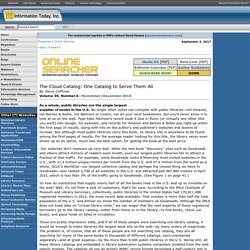

*Library as Platform David Weinberger (Start at around 14:30) Long-time CIL Attendee Marshall Breeding (L) and David Weinberger David Weinberger opened with two questions: Why Hacking Now?

Why Isn’t Every Knife a Swiss Army Knife? We have this opportunity to hack now because Everything is networked. Wenger 16999 Swiss Army Knives have evolved into do-anything tools, like the Wenger 16999, which costs over $1200 and weighs over 7 pounds! Libraries anticipate what readers need, even with electronic resources. 3 paths to a future without anticipation. We are in a position to put a platform, or portal, under our services, which gives people a way to build applications. Graph of BooksLibrary graphs will provide an infrastructure to allow people to get in to their data. To hack libraries, we must hack the future: take a different approach to how we view the future, which will allow us to enrich our assets, and develop an infrastructure of knowledge. The New York Public Library. The catalog could be considered the backbone of any working library.

Performing an essential service, the catalog informs staff and patrons what materials are held and where in the library they can be found. As libraries have changed throughout history, the catalog, and how it has been used, has evolved as well. Some of the earliest catalogs still in existence, originating from medieval libraries, were simply lists written on the inside covers and margins of books in the collection. For these early libraries, containing a couple hundred volumes at most, this system was sufficient to keep track of the collection. However, during the Renaissance, as libraries grew in size, external catalogs started being produced which listed all the works held in the library. At NYPL Labs, we are fascinated with our catalog and the possibilities its data represents. Subjects Headings for A Team of Rivals Joseph Priestley's A New Chart of History from 1769. Library Catalogues of the Future: A Social Space and Collaborative Tool?
What is Social tagging. Patron-Driven Subject Access: How Librarians Can Mitigate That “Power to Name” In Brief Information organization and access is one of the core goals of librarianship.

However, as librarians, we have the power to control what language patrons must use when searching for items. This power often manifests itself by limiting access to materials by and/or about oppressed or otherwise marginalized groups, due to how we label those materials. Many librarians, such as Sanford Berman, criticize this language and suggest better language for subject access. But does this “better language” match how patrons search? Introduction. American Libraries Magazine. OCLC printed its last library catalog cards on October 1, 2015, ending an era that lasted more than 150 years.

As technology changes library cataloging, we look back at its history and forward into its future. Today when we say “technology,” it is often shorthand for “computer technology.” Of course this is not the only technology in our lives, but it is the one that defines our modern age. A century and a half ago, the defining technology was electricity and all things electric. The light bulb was literally the bright idea of the day. If we move back in time, we see ages defined by their technological innovations: steam power, water power, or the precision use of metals that made it possible to create accurate timepieces and to automate the production of fine cloth.
Basically, it’s technology all the way back to fire and the first stone axes. The birth of the catalog The library catalog technology of Cutter’s day was a printed book. Uniform innovations Going online. The Cloud Catalog: One Catalog to Serve Them All. As a whole, public libraries are the single largest supplier of books in the U.S.

No single other outlet can compete with public libraries—not Amazon, not Barnes & Noble, not Walmart or Costco, not all your local bookstores. But you’d never know it to look at us on the web. Type Kate Atkinson’s recent book A God in Ruins (or virtually any other title you want) into Google, for example, and records for Amazon and Barnes & Noble pop right up within the first page of results, along with hits on the author’s and publisher’s websites and dozens of reviews.
But although most public libraries carry this book, no library site is anywhere to be found among the first pages of results. Public Library Catalog as Social Space (Spiteri) Skim. OPACs, Users, and Readers’ Advisory: Exploring the Implications of User-Generated Content for Readers’ Advisory in Canadian Public Libraries: Cataloging & Classification Quarterly: Vol 52, No 4.
Overhyped Fad or Missed Opportunity? A History of Academic Libraries and the Social Web (2017) About The Library of Congress. Yes.

We really are THE Library of Congress. We invited your tags and comments and you responded. Wow, did you respond! Thank You. The identifying information is appreciated--many of our old photos came to us with very little description. We placed only one tag ("Library of Congress") and two machine tags on each photo when we loaded them. NARA: Citizen Archivist Missions.